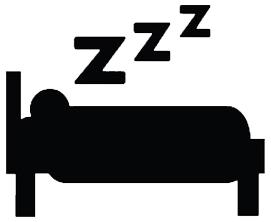Obstructive Sleep Apnea & Snoring

Snoring:
Snoring is a result of relaxation and vibration of one or multiple anatomic structures in the throat or upper airway as you progress from a light sleep to a deep sleep. Snoring is quite common, affecting at least 25 percent of young and middle aged adult men and 12 percent of woman. These rates become much higher above the age of 60.
The most recent literature indicates that snoring may be more than just a noisy nuisance. Snoring itself may cause significant disruptions in your sleep causing you to become sleep deprived. It may also be a factor in the development of high blood pressure, heart disease, vascular disease, lung disease, and strokes. Snoring is often an important indicator that you may have obstructive sleep apnea.
Factoid:
Causes of snoring:
- Obesity
- Enlarged tonsils or adenoids
- The common cold and sinusitis
- Long or thickened uvula and soft palate
- Recessed lower jaw and other facial skeletal abnormalities
- Pregnancy
- Nasal congestion and other intranasal conditions
- Obstructive sleep apnea
- Allergies
- Alcohol consumption
- Medications such as tranquilizers and other medications that can affect your central nervous system
Obstructive Sleep Apnea (OSA):
Obstructive Sleep Apnea is the most common type of sleep apnea and is a result of obstruction, collapse or blockage of the upper airway in the nose and throat. This obstruction leads to multiple pauses in breathing while you are asleep, causes a significant disruption in sleep, and is a leading cause of daytime sleepiness. Obstructive Sleep Apnea is frequently undiagnosed and can affect both children and adults.
Untreated obstructive sleep apnea can cause high blood pressure, heart disease, lung disease, strokes, and premature death.
Symptoms and Signs:
- Excessive daytime sleepiness
- Restless sleep or difficulty sleeping
- Loud snoring
- Observed stoppage of breathing while asleep (Apnea)
- Morning headaches
- Mood changes
- Falling asleep during the day while sitting or driving
- Difficulty with memory
- High blood pressure
Diagnosis
Overnight sleep study (Polysomnogram): This is the “Gold Standard” and classic way to test for obstructive sleep apnea.
- Monitor stages of sleep, breathing patterns, oxygen levels in the blood, heart rhythms, and limb movements.
- Conducted overnight in a sleep center.
- Comfort of your own private room.
In-Home sleep study: Monitors the most essential aspects of sleep to diagnose obstructive sleep apnea. We provide In-home sleep studies using the WatchPAT™ device
- Convenient in home testing for obstructive sleep apnea using a simple device like a small watch, probe on your finger, and sticky pad on your chest.
The Diagnostic Sleep Laboratory at Mercy Medical Center: The Lung Center at Mercy offers testing and treatment for sleep disorders in their full-service diagnostic sleep lab.
STOP-Bang Sleep Apnea Questionnaire:
- A simple screening tool to determine your risk for having Obstructive Sleep Apnea. (Chung F et al. Anesthesiology 2008; 108: 812-821)
- To complete the questionnaire click on the following link “www.stopbang.ca/osa/screening.php”.
Treatment for Obstructive Sleep Apnea (OSA):
- CPAP (continuous positive airway pressure): These devices will treat your OSA and usually eliminate snoring.
- Surgery: The most common surgery performed to treat Obstructive Sleep Apnea is Uvulopalatopharyngoplasy (UPPP). Nasal surgery and surgery in the face and neck are other options.
- Oral Appliance Therapy: These devices are used to treat patients with mild to moderate OSA. Oral appliances hold the lower jaw forward, keep the airway open, and prevent the tongue from blocking the airway. Oral appliances usually reduce or eliminate snoring.
- Lifestyle Changes:
- Avoid alcohol, sedatives, sleeping pills, medications that relax the central nervous system
- Sleep on your sides and avoid sleeping on your back
- Maintain a healthy weight
- Quit smoking
Do you need a
bi-lingual ENT doctor?
Alan E. Oshinsky, MD and
Ileana I. Showalter, MD,
are both fluent in Spanish.
To make an appointment
Call 410 837-6126
410-837-6126
Looking for an ENT Doctor?
Alan E. Oshinsky, MD, PA and his team are just a phone call away
